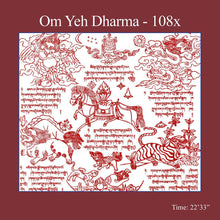Mantra Practice Volume 6 - Om Yeh Dharma
$7.99
$0.00( / )
Om Yeh Dharma Hetu Prabhava Hetu Teshan Tathagato Hyawadat Teshan Jayo Nirodha Evam Vadi Maha Shramana Soha "Those things which proceed from a cause, of these the Tathagata has told the cause, and also how they come to an end. This is the teaching of the Great Renunciate." This famous...
Om Yeh Dharma Hetu Prabhava Hetu Teshan Tathagato Hyawadat Teshan Jayo Nirodha Evam Vadi Maha Shramana Soha
"Those things which proceed from a cause, of these the Tathagata has told the cause, and also how they come to an end. This is the teaching of the Great Renunciate."
This famous mantra - the dependent arising (Tib. tendrel, Skt. Pratityasamutpada) mantra, is actually a summary of the teachings of the Buddha. Pratityasamutpada is the name for the Buddha's teaching on cause and effect, in which he demonstrated how all situations arise through the coming together of various factors.
In the Theravadin tradition, it refers in particular to the twelve nidanas, or links in the chain of samsaric becoming. These twelve are portrayed in the familiar drawing of the Wheel of Life. When the practitioner is finally able to break one of these links-for example by overcoming ignorance or attachment- the entire cycle of suffering ceases and enlightenment is attained. The teaching of Pratityasamutpada can be summarized in this pratitya-essence mantra.
A mala consists of 108 or 27 beads. Buddha recommended the mantra practice as a path to enlightenment for ordinary people. Counting mantra with a mala engages the hand (body), the voice (speech) and the mind by visualizing the deity. Hold the mala gently and with respect. Start counting with the first bead after the "guru" bead. Count a bead for each completed recitation. When you complete either 108 or 4x27 recitations, do not pass over the "guru" bead. Instead, flip the mala around 180 degrees, and keep going the same direction. In closing you may like to dedicate merit to all sentient beings.


